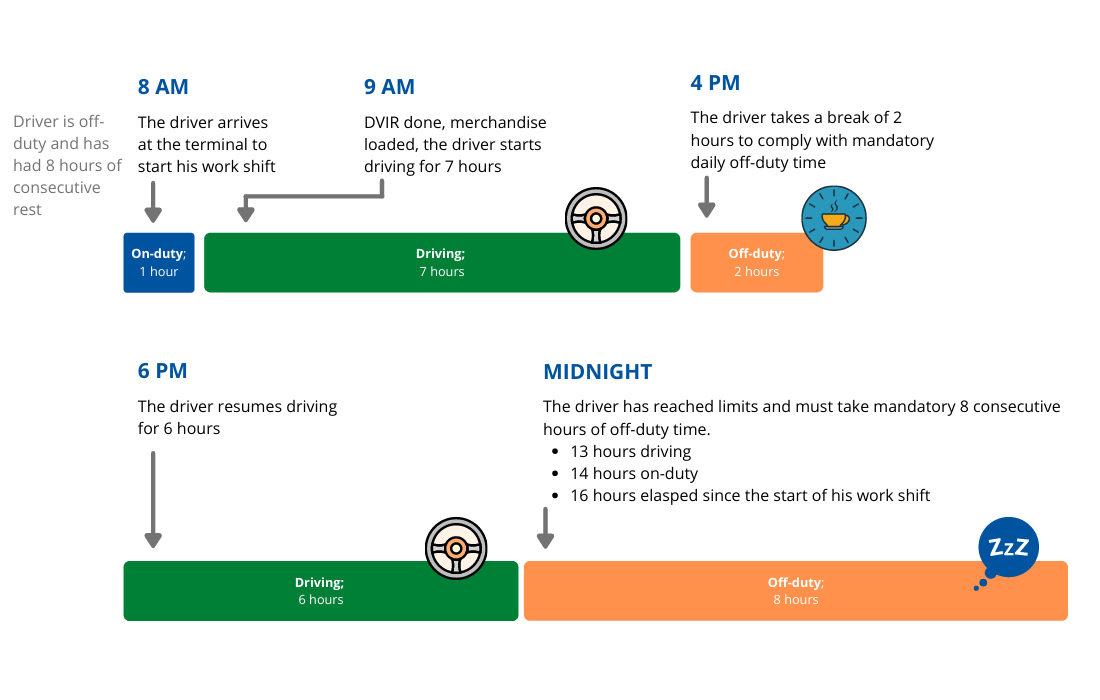Federal and provincial regulations, sleeper berth provisions, exemptions …
Are you overwhelmed with the intricacies of the HOS rules?
On June 13, 2019, the ELD final rule was published in the Canada Gazette, Part II. The Canadian ELD rule came into effect on June 12, 2021 with a period of progressive enforcement focused on education and awareness until June 2022. The new ELD regulation will level the playing field in the transport industry making all the carriers accountable to the same law. To start, the new regulation only applies to federally regulated fleets, which means nearly 157,500 commercial vehicle drivers. While electronic logging solutions might not be mandatory for carriers falling under provincial regulations (check out our blog Understanding the Canadian ELD Mandate’s Progressive Enforcement for details), they will still need to record and track the drivers’ Hours of Service (HOS). Your ELD device is a great tool to help you comply with the various HOS regulations, no matter which jurisdiction you fall under.
Does your fleet fall under the federal or the provincial rule?
A Canadian carrier could fall under federal or the provincial jurisdiction. If you operate one vehicle in multiple provinces, territories or states, your entire fleet is federally regulated. On the other hand, a company operating within a province’s limits falls under provincial jurisdiction.
Federal vs. provincial rules
While sensibly similar, federal and provincial HOS rules contain slight differences that sometimes provide more leeway in driving and on-duty time. The intricacies of these HOS rules can sometimes be confusing. The federal and provincial rule overviews that follow help illustrate the differences.
Canadian Federal rule – South of the 60th parallel
In the federal rule, there are 3 types of limitations that apply to a driver’s time: daily limits, work shift limits and cycle limits. It is a driver’s responsibility to comply with all 3 limitations at all times.
A day is a period of 24 consecutive hours that starts and ends at the same time each day.
Within a day, the driver should not exceed 13 hours of driving time and may no longer drive once they have reached 14 hours of on-duty time. Moreover, a driver must take at least 10 hours of off-duty time in a day. This time must include at least 2 hours of off-duty time other than the mandatory 8 consecutive hours of off-duty time. These 2 hours may be divided into breaks of no less than 30 minutes in length.
A work shift is the period of time that a driver is “on the job”. The work shift contains all the activities performed for a carrier between two off-duty periods of at least eight consecutive hours. During their work shift, a driver should not exceed 13 hours of driving, and may not drive once they have reached 14 hours of on-duty or after 16 hours have elapsed since they started the work shift.

Figure 1: Example of a work shift compliant to the federal rule
SOR/2005-313 sections 12 to 14: https://laws-lois.justice.gc.ca/eng/regulations/SOR-2005-313/
Finally, Canada has two duty cycles: cycle 1, which is 7 days in length, and cycle 2, which is 14 days.
In cycle 1, no driving is allowed after 70 hours on-duty in any 7 days. In cycle 2, drivers must stop driving once they have reached 120 hours on-duty in any 14 days, or they must stop driving once they have reached 70 hours on-duty without taking at least 24 consecutive hours off -duty. It is important to understand that the cycles are a set length of time, but are not set at a particular point in time.
Provincial rule variations
There are slight differences in the federal and provincial HOS regulations. If your fleet falls under these jurisdictions, you may benefit from extra driving, and on-duty time in specific instances.
| Federal South of the 60th parallel SOR/2005-313 | Federal North of the 60thparallel SOR/2005-313 | Alberta 5 Reg 317/2002 | Saskatchewan Chapter H-3.1 Reg 12 (March 13, 1996) | Manitoba Regulation 72/2007 | |
|---|---|---|---|---|---|
| Driving time in a day | 13 hours | 15 hours | 13 hours | 13 hours | 13 hours |
| On-duty time in a day | 14 hours | 18 hours | 15 hours | 15 hours | 14 hours |
| Mandatory off-duty time | 10 hours7 | 8 consecutive hours to start a work shift | 8 consecutive hours to start a work shift | 8 consecutive hours to start a work shift | 10 hours7 |
| Off-duty deferral1 | Off-duty time reduced to no less than 8 hours Every second day | Not applicable | Off-duty time reduced to no less than 4 hours Once in any period of 7 consecutive days6 | Off-duty time reduced to no less than 4 hours Once in any period of 7 consecutive days6 | Off-duty time reduced to no less than 8 hours Every second day |
| Work Shift Elapsed Time | 16 hours | 20 hours | Not applicable | Not applicable | 16 hours |
| Cycle 1 limits | 70 hours in 7 days2 | 80 hours in 7 days2 | Not applicable | Not applicable | 70 hours in 7 days2 |
| Cycle 2 limits | 120 hours in 14 days2;3 | 120 hours in 14 days 4,2 | Not applicable | Not applicable | 120 hours in 14 days2;3 |
1. (a) the off-duty time deferred is not part of the mandatory 8 consecutive hours of off-duty time;
(b) The total off-duty time taken in the 2 days is at least 20 hours;
(c) the off-duty time deferred is added to the 8 consecutive hours of off-duty time taken in the second day;
(d) The total driving time in the 2 days does not exceed 26 hours; and
(e) Driver declares in the “Remarks” section of the daily log that he is deferring off-duty time and indicates whether he is driving under day1 or day2. On the ISAAC tablet, this is done automatically when using the deferral button.
2. Driver must take at least 24 consecutive hours of off-duty time in the preceding 14 days.
3. Driver may no longer drive once they have reached 70 hours of on-duty time over a period of 7 days without taking at least 24 consecutive hours of off-duty time.
4. Driver may no longer drive once they have reached 80 hours of on-duty time over a period of 7 days without taking at least 24 consecutive hours of off-duty time.
5. Alberta Hours of Service Regulation AR 317/2002 requires a driver of a commercial motor vehicle to take time breaks. Specifically, a driver may continuously drive a vehicle according to the following:
(a) for a period of time of up to 4 consecutive hours if at the conclusion of driving for that period of time the driver takes at least 10 consecutive minutes of off-duty or non-driving time, or
(b) for a period of time that exceeds that permitted under clause (a) but does not exceed 6 consecutive hours if at the conclusion of driving for that period of time the driver takes at least 30 consecutive minutes of off-duty or non-driving time.
6. The last work shift of a driver does not exceed 15 hours and the total consecutive hours off –duty immediately following the next work shift is no less than 8 hours plus the number of hours by which the driver’s time off –duty has been reduced.
7. 8 consecutive hours to start a work shift, plus 2 hours that does not form part of a period of 8 consecutive hours. The 2 hours of off-duty time may be distributed throughout the day in blocks of no less than 30 minutes each.
Special cases and exemptions
The federal and provincial rules allow for some exemptions. It’s important to choose a partner that supports the special cases to be compliant. Here are a few examples.
Emergency conditions
Hours of service limitations may be extended for a driver who requires more driving time in an emergency. This allows the driver to reach the first destination that provides safety for the occupants of the commercial vehicle.
Adverse driving conditions
A driver who encounters unexpected adverse driving conditions while driving the vehicle during a trip south of latitude 60°N may extend the permitted 13 hours of driving time and reduce the 2 hours of daily off-duty time required by the amount of time needed to complete the trip if:
- the driving, on-duty and elapsed time in the cycle the driver followed is not extended more than 2 hours;
- the driver still takes the required 8 consecutive hours of off-duty time; and
- the trip could have been completed under normal driving conditions without the reduction.
Sleeper berth provision
If a commercial vehicle has an approved sleeper berth, a driver can meet the mandatory off-duty time and daily off-duty time requirements by accumulating off-duty time in no more than 2 periods. These two periods must be spent resting in the sleeper berth. The conditions to comply with the splitting of daily off-duty time, in the federal regulation, differs for a single driver and a team of drivers.
How does this affect your choice of an ELD solution?
Fleet management solutions can vary in the extent of the rules they cover. While all ELD solutions record the hours of service, only a few can assist you in proactively managing your HOS by taking into account the provincial rules and the special cases.
If for instance your ELD provider only supports the federal rule, and you solely operate in Alberta, the HOS violation warning will not indicate the correct number of remaining driving hours. As a consequence, your dispatcher and driver will have to manually calculate the remaining hours of service and input the appropriate corresponding notes. The potential loss of productivity could have an impact on your profit margins.
With the progressive enforcement of Canadian ELD rule, you need to familiarize yourself with the HOS rules. While researching the market offering, you should check whether your shortlist of ELD providers support the rules of the territory where you operate (federal vs. provincial) as well as your mode of operation (use of a sleeper berth, driver teams, exemptions, etc.). This goes to ensure your fleet’s compliance.









